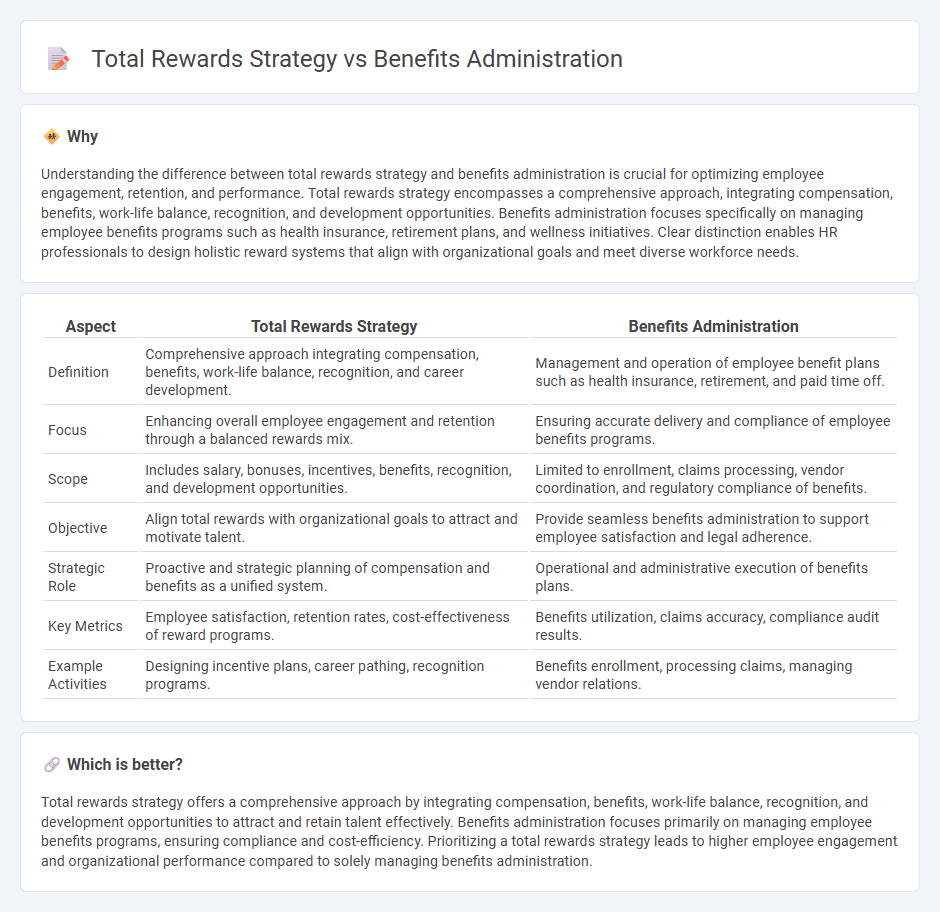
Total rewards strategy encompasses a comprehensive approach that integrates compensation, benefits, work-life balance, and recognition programs to attract, motivate, and retain talent effectively. Benefits administration focuses specifically on the operational management of employee benefits such as health insurance, retirement plans, and paid time off. Discover how aligning total rewards with organizational goals can enhance employee engagement and drive business success.
Why it is important
Understanding the difference between total rewards strategy and benefits administration is crucial for optimizing employee engagement, retention, and performance. Total rewards strategy encompasses a comprehensive approach, integrating compensation, benefits, work-life balance, recognition, and development opportunities. Benefits administration focuses specifically on managing employee benefits programs such as health insurance, retirement plans, and wellness initiatives. Clear distinction enables HR professionals to design holistic reward systems that align with organizational goals and meet diverse workforce needs.
Comparison Table
| Aspect | Total Rewards Strategy | Benefits Administration |
|---|---|---|
| Definition | Comprehensive approach integrating compensation, benefits, work-life balance, recognition, and career development. | Management and operation of employee benefit plans such as health insurance, retirement, and paid time off. |
| Focus | Enhancing overall employee engagement and retention through a balanced rewards mix. | Ensuring accurate delivery and compliance of employee benefits programs. |
| Scope | Includes salary, bonuses, incentives, benefits, recognition, and development opportunities. | Limited to enrollment, claims processing, vendor coordination, and regulatory compliance of benefits. |
| Objective | Align total rewards with organizational goals to attract and motivate talent. | Provide seamless benefits administration to support employee satisfaction and legal adherence. |
| Strategic Role | Proactive and strategic planning of compensation and benefits as a unified system. | Operational and administrative execution of benefits plans. |
| Key Metrics | Employee satisfaction, retention rates, cost-effectiveness of reward programs. | Benefits utilization, claims accuracy, compliance audit results. |
| Example Activities | Designing incentive plans, career pathing, recognition programs. | Benefits enrollment, processing claims, managing vendor relations. |
Which is better?
Total rewards strategy offers a comprehensive approach by integrating compensation, benefits, work-life balance, recognition, and development opportunities to attract and retain talent effectively. Benefits administration focuses primarily on managing employee benefits programs, ensuring compliance and cost-efficiency. Prioritizing a total rewards strategy leads to higher employee engagement and organizational performance compared to solely managing benefits administration.
Connection
Total rewards strategy integrates compensation, benefits administration, and employee recognition to enhance workforce motivation and retention. Effective benefits administration ensures alignment with total rewards goals by managing health insurance, retirement plans, and wellness programs tailored to employee needs. This connection drives organizational performance by fostering employee satisfaction and loyalty through comprehensive and competitive offerings.
Key Terms
**Benefits Administration:**
Benefits administration streamlines the management of employee health, retirement, and wellness programs, ensuring compliance with regulatory requirements while optimizing cost-efficiency. It enhances employee satisfaction by providing clear communication and easy access to benefit options, reducing administrative burdens for HR teams. Explore how effective benefits administration can transform your workforce engagement and organizational performance.
Health Insurance
Health insurance plays a critical role in both benefits administration and total rewards strategy, serving as a key component to attract and retain talent while managing employee well-being and healthcare costs. Benefits administration focuses on the efficient management, compliance, and communication of health insurance plans, ensuring employees understand their coverage options and receive timely support. Explore how integrating health insurance into a total rewards strategy enhances organizational value and employee satisfaction.
Retirement Plans
Retirement plans in benefits administration emphasize managing and administering pension schemes, 401(k) options, and employee contributions to ensure compliance and timely fund allocation. Total rewards strategy integrates these retirement benefits with broader compensation elements such as bonuses, health insurance, and wellness programs to enhance overall employee value proposition and retention. Explore how aligning retirement plans with total rewards strategy can optimize workforce satisfaction and financial security.
Source and External Links
What Is Benefits Administration? Benefits and Process | Paycom Blog - Benefits administration involves evaluating, selecting, managing, and enrolling employees in benefits programs, and it improves employee satisfaction through tailored benefits based on feedback and legal compliance.
What Is Benefits Administration? - Paycor - Effective benefits administration supports recruitment, retention, and employee well-being by providing compliant benefits like health insurance and paid time off, ultimately boosting company culture and reducing absenteeism.
Manage employee benefits: A complete guide | Thatch Blog - Benefits administration best practices include using software for management, ensuring compliance, clear employee communication, and tailoring benefits to workforce needs to maximize investment value.
 dowidth.com
dowidth.com